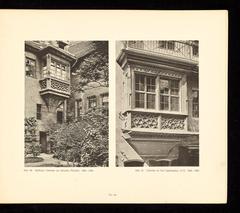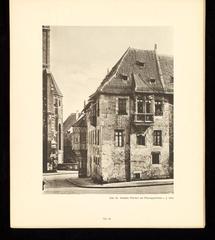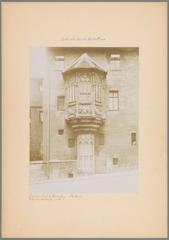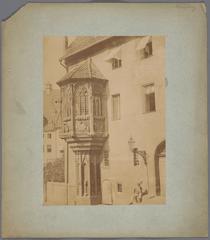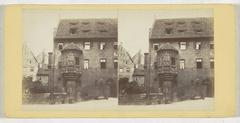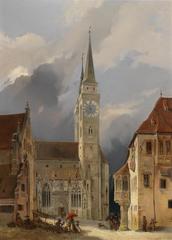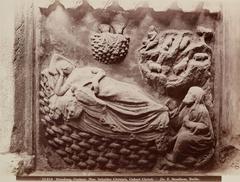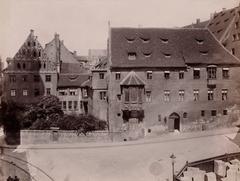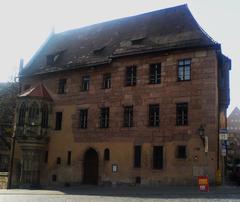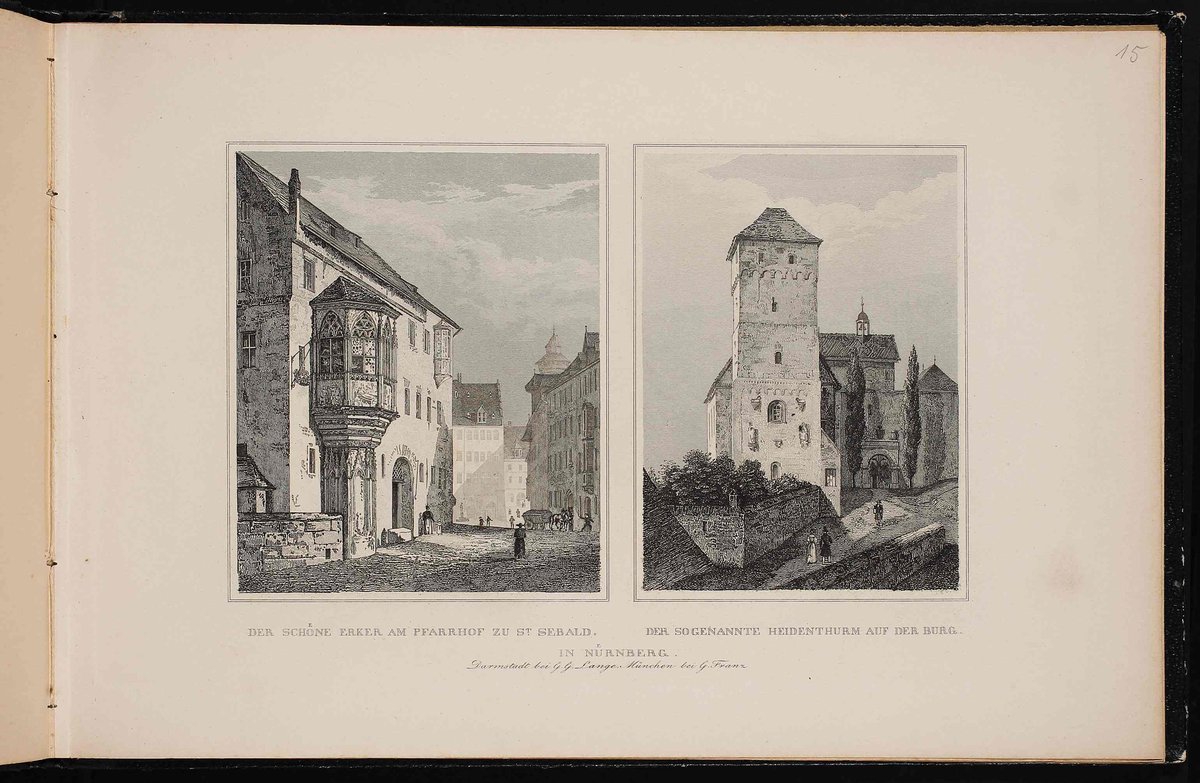
Sebalder Pfarrhof Visiting Hours, Tickets, and Guide to Nuremberg Historical Sites
Date: 14/06/2025
Introduction: Discover the Sebalder Pfarrhof – A Key Nuremberg Historical Site
In the cobbled heart of Nuremberg’s medieval old town, directly opposite the venerable St. Sebaldus Church, stands the Sebalder Pfarrhof. This remarkable ecclesiastical complex, dating primarily to the 14th century, is one of Nuremberg’s best-preserved architectural treasures. Celebrated for its authentic Gothic features—such as the iconic Chörlein (oriel chapel) and original timber ceilings—the Pfarrhof is not just a testament to medieval craftsmanship but also a living monument reflecting centuries of religious, social, and cultural evolution (nuernberg-aha.de; sebalduskirche.de).
The Sebalder Pfarrhof is also a focal point for dialogue between Nuremberg’s Christian and Jewish pasts, most notably evidenced by the discovery of a 14th-century Jewish gravestone and a Hebrew protective inscription during recent restorations (nn.de; mekomot-nuernberg.de). Today, the site is both a place of historical reflection and vibrant contemporary culture.
This detailed guide explores the Sebalder Pfarrhof’s history, architecture, visitor information (including hours, tickets, accessibility, and tours), and its role within Nuremberg’s broader historical landscape.
Medieval Origins and Historical Context
Constructed between 1361 and 1379, the Sebalder Pfarrhof played a pivotal role as the residence and administrative center for the clergy of St. Sebaldus Church. Its situation in the Weinmarktviertel (Wine Market Quarter) reflects the medieval city’s tendency to cluster religious and civic institutions in close proximity for both symbolic and practical reasons (nuernberg-aha.de). Earlier phases, including the “Wöchnerstube” at the southeast corner, date back to the 13th century and are among the oldest surviving structures in the city (sebalduskirche.de; tourismus.nuernberg.de).
By the early 14th century, the Pfarrhof expanded into a rare four-winged courtyard complex, accommodating both people and livestock—a testament to the multifunctional nature of ecclesiastical estates. The original timber beam ceilings from 1312, enhanced by clay infill for insulation and fire resistance by 1380, are still visible today (Kurzführer Pfarrhof PDF).
Architectural Highlights and Distinctive Features
The Chörlein (Oriel Chapel)
The Chörlein, or oriel chapel, is the Pfarrhof’s most iconic architectural feature. Projecting from the façade, it boasts delicate tracery and pointed arches—a hallmark of 14th-century Gothic style (nuernberg-aha.de). Originally serving as a private prayer space, the Chörlein symbolizes the integration of public religious practice and personal devotion.
Courtyard and Building Ensemble
The Pfarrhof’s four wings encircle a central courtyard, constructed from local sandstone and timber. This layout provided security, communal space, and reflects the daily rhythms of medieval ecclesiastical life.
Artistic Details
Inside, original wall paintings with floral and foliate motifs survive in niches, especially in the Kapitelsaal (chapter hall). These rare late 14th-century decorations offer insight into the symbolic language and aesthetic values of the period (Kurzführer Pfarrhof PDF).
Medieval Infrastructure
The preserved kitchen complex, complete with an open hearth and a three-story latrine tower, highlights the advanced domestic infrastructure required for a large clerical household.
Layers of Cultural Significance
The Sebalder Pfarrhof stands as a palimpsest of Nuremberg’s religious, social, and intercultural history. Its evolution mirrors the city’s rise as a major urban center and the increasing veneration of St. Sebaldus, the city’s patron saint. The Pfarrhof’s clergy—often drawn from the Franconian nobility—were key figures in both spiritual and municipal governance (sebalduskirche.de).
Jewish Heritage and Rediscovery
During renovations in 2018 and 2019, a medieval Jewish gravestone (matzevah) from 1334 was discovered embedded above the entrance. It commemorates a woman named Gutlin and is inscribed in Hebrew. A separate protective Hebrew inscription, “Through this gate shall no sorrow come,” was found on a wooden door, dating from the early 16th century (nn.de; mekomot-nuernberg.de). These finds powerfully illustrate the intertwined histories of Nuremberg’s Christian and Jewish communities.
Interfaith Dialogue
The gravestone and Hebrew blessing are now central elements of the “Stein & Tür” (Stone & Door) exhibition, developed in collaboration with the Jewish Community of Nuremberg and the association Geschichte Für Alle e.V. The exhibition fosters reflection on memory, reconciliation, and the city’s plural heritage.
Restoration and Contemporary Use
Following extensive restoration—completed in the early 2020s—the Sebalder Pfarrhof has been lauded for balancing heritage conservation with modern accessibility (ardmediathek.de). Original features such as the medieval timber ceilings, wall paintings, and kitchen-latrine complex were carefully conserved.
Today, the Pfarrhof is a vibrant cultural hub, hosting concerts, readings, and community events, especially during the annual ION Music Festival. The on-site Café Maulbeere offers a unique blend of historical ambiance and contemporary hospitality (kirchentag.de; kammermusiktheater.de).
Visiting the Sebalder Pfarrhof: Practical Information
Location and Access
- Address: Albrecht-Dürer-Platz 1, 90403 Nürnberg
- Public Transport: U-Bahn station “Lorenzkirche” (U1), bus line 36 (“Burgstraße”), both within easy walking distance.
- Parking: Limited in the old town. Use public transport or nearby garages if arriving by car.
Visiting Hours and Tickets
- General Hours: Daily 9:00–18:00 (may extend during events; check for updates) (Sebalduskirche)
- Exhibition “Stein & Tür”: Open daily, 9:00–18:00, free admission.
- Events: Most lectures and community events are free; some concerts may require tickets (Musikfest ION).
Accessibility
- Wheelchair Access: Main areas, courtyard, and exhibition are accessible; some historic rooms may have uneven floors or steps.
- Assistance: Contact the parish office for specific needs or to book group tours.
Facilities
- Café “Die Maulbeere”: Open during the day in the courtyard, especially lively during festival season.
- Restrooms: Available on-site.
- Visitor Services: Parish office open Monday–Friday, 9:00–17:00 for information and bookings.
Events and Cultural Programming
Sebalder Pfarrhof hosts a lively array of cultural activities:
- Concerts: Classical and chamber music, especially during Musikfest ION (Musikfest ION).
- Lectures & Talks: Monthly programs on history, architecture, and interfaith dialogue (Stadtarchiv Nürnberg).
- Religious Services: Including ecumenical vespers and special occasions.
Check the parish website and city event calendar for schedules.
The “Stein & Tür” Exhibition
This permanent exhibition centers on the Jewish gravestone and Hebrew-inscribed door discovered during renovation. Developed with the Israelitische Kultusgemeinde Nürnberg and Geschichte Für Alle e.V., it highlights themes of memory, reconciliation, and the shared heritage of Nuremberg’s faith communities (mekomot-nuernberg.de).
- Admission: Free
- Languages: Exhibition texts in German; audio guides and translations may be available.
Nearby Attractions and Photographic Spots
The Pfarrhof is ideally placed for exploring:
- St. Sebaldus Church: Adjacent, noted for Romanesque and Gothic architecture.
- Albrecht Dürer House: The Renaissance artist’s home, a short walk away.
- Hauptmarkt: Nuremberg’s main square, famous for markets and festivals.
Photographers will appreciate the Chörlein’s stonework, the atmospheric courtyard, and the interplay of light and history.
Practical Tips for Your Visit
- Plan Ahead: Check event calendars for concerts or lectures during your visit.
- Combine Attractions: Pair your visit with nearby historical sites for a full day of exploration.
- Consider the Season: Summer features lively concerts and open-air café culture; winter brings atmospheric quiet.
- Accessibility: Some historic rooms have steps or uneven floors—contact ahead for specific needs.
Frequently Asked Questions (FAQ)
Q: What are the Sebalder Pfarrhof visiting hours?
A: Daily from 9:00 to 18:00; check for extended hours during events.
Q: Is there an admission fee?
A: No, entry to the Pfarrhof and exhibitions is free. Some special events may require tickets.
Q: Are guided tours available?
A: Yes, contact the parish office for booking and details.
Q: Is the site wheelchair accessible?
A: Most main areas and the courtyard are accessible; some historic rooms may not be.
Q: Can I take photographs?
A: Non-flash photography is allowed except during concerts or private events.
Contact Information
- Parish Office: Burgstr. 1–3, 90403 Nürnberg
Phone: +49 911 2142500
Email: [email protected] (Sebalduskirche Kontakt) - Events: Musikfest ION, Stadtarchiv Nürnberg
Summary and Final Tips
The Sebalder Pfarrhof is a multifaceted jewel woven into Nuremberg’s medieval tapestry. Its Gothic architecture, highlighted by the Chörlein and preserved medieval interiors, offers a rare glimpse into 14th-century ecclesiastical design. More profoundly, the rediscovered Jewish gravestone and Hebrew blessing invite visitors to engage with the city’s complex religious and cultural narratives, encouraging interfaith dialogue and reflection (nn.de; mekomot-nuernberg.de).
Today, the Pfarrhof is not only a testament to medieval artistry but also a vibrant hub for exhibitions, concerts, and community gathering, with easy access and free admission. Its proximity to other landmarks makes it an essential stop for anyone exploring Nuremberg’s historical sites (sebalduskirche.de; tourismus.nuernberg.de).
Before your visit, check for updated hours and events, consider joining a guided tour, and enjoy the on-site café. Download the Audiala app for audio tours and stay informed about cultural programming.
References
- nuernberg-aha.de
- sebalduskirche.de
- tourismus.nuernberg.de
- mekomot-nuernberg.de
- nn.de
- nuernberg.de
- ardmediathek.de

